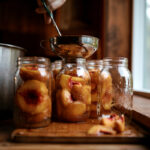Syrups for Canning Fruit
Most fruit is canned in syrup, and this recipe guide to canning syrups will allow you to choose the right amount of sugar for your batch size. They're written using standard sugar concentrations for either 9 pint or 7 quart batches. Choose your syrup concentration and batch size before beginning.
Servings: 1 batch (9 pints or 7 quarts, see notes)
Ingredients
Extra Light Syrup
- 3/4 cup sugar for 9 pint batch, or 1 1/4 cups for 7 quart batch
- 6 1/2 cups water for 9 pint batch, or 10 1/2 cups water for a 7 quart batch
Light Syrup
- 1 1/2 cups sugar for 9 pint batch, or 2 1/4 cups for 7 quart batch
- 5 3/4 cups water for 9 pint batch, or 9 cups water for a 7 quart batch
Medium Syrup
- 2 1/4 cups sugar for 9 pint batch, or 3 3/4 cups for 7 quart batch
- 5 1/4 cups water for 9 pint batch, or 8 1/4 cups water for a 7 quart batch
Heavy Syrup
- 3 1/4 cups sugar for 9 pint batch, or 5 1/4 cups for 7 quart batch
- 5 cups water for 9 pint batch, or 7 3/4 cups water for a 7 quart batch
Extra Heavy Syrup
- 4 1/4 cups sugar for 9 pint batch, or 6 3/4 cups for 7 quart batch
- 4 1/4 cups water for 9 pint batch, or 6 1/2 cups water for a 7 quart batch
Instructions
- Choose your syrup strength and batch size from the lists above. This recipe is designed such that you choose your syrup strength and batch size (ie Light Syrup for Pints) for a tested fruit canning recipe. Don't use all the quantities above combined.
- Combine the measured sugar and water in a saucepan. Heat, stirring, until the sugar dissolves; bring to a full rolling boil.
- For Raw Pack: Pack prepared fruit into hot jars. Ladle boiling syrup over fruit, leaving 1/2 inch headspace unless your recipe states otherwise.
- For Hot Pack: Add prepared fruit to the boiling syrup; return to a boil for the time specified by your fruit recipe (often 1–2 minutes). Pack fruit and syrup into hot jars, leaving 1/2 inch headspace.
- Remove air bubbles, adjust headspace, wipe rims, apply lids and bands.
- Process jars according to your specific fruit recipe, including altitude adjustments.
Notes
This recipe is written as a customizable guide that allows you to choose from extra light to heavy syrup, for standard canner batch sizes of 9 pints or 7 quarts. Choose your batch size and syrup concentration before beginning.
• Medium: commonly used commercially for sweet apples, sweet cherries, berries, grapes. (~30% sugar)
• Heavy: helpful for tarter fruits such as tart apples, apricots, sour cherries, gooseberries, nectarines, peaches, pears, plums. (~40% sugar)
• Extra-Heavy: very sweet, firming effect; use sparingly for making candy. (~50% sugar)
• No-sugar options: Use water or 100% fruit juice (white grape juice is a good neutral choice). Expect a less sweet result; flavor remains brighter than plain water alone.
• Modern calorie-free sweeteners (e.g., sucralose, monkfruit blends) haven’t been comprehensively tested for canning quality; many people use them, but heat stability and flavor can vary. If avoiding sugar, fruit juice is a reliable alternative.
• Make-ahead: Extra syrup can be refrigerated up to 1 week or frozen for later batches.
• Non-Fruit Preserves: These syrups also work for “fruit-style” vegetables like rhubarb, and for pressure-canned sweet potatoes or pumpkin cubes when a sweet pack is desired; always follow the tested recipe for the specific food.
Recommended Syrup Use by Fruit (Quick Guide)
• Extra-Light or Light: sweetest fruits or when you want a very natural, fruit-forward flavor. (~10% sugar for extra light, or ~ 20% for light)• Medium: commonly used commercially for sweet apples, sweet cherries, berries, grapes. (~30% sugar)
• Heavy: helpful for tarter fruits such as tart apples, apricots, sour cherries, gooseberries, nectarines, peaches, pears, plums. (~40% sugar)
• Extra-Heavy: very sweet, firming effect; use sparingly for making candy. (~50% sugar)
Variations
• Alternative sweeteners: You can substitute honey, light maple syrup, or agave for part or all of the sugar. Most sources suggest 2/3 to 3/4 cup liquid honey per 1 cup sugar. Choose light, mild sweeteners (e.g., clover honey, Grade A golden maple) to keep the fruit flavor front and center.• No-sugar options: Use water or 100% fruit juice (white grape juice is a good neutral choice). Expect a less sweet result; flavor remains brighter than plain water alone.
• Modern calorie-free sweeteners (e.g., sucralose, monkfruit blends) haven’t been comprehensively tested for canning quality; many people use them, but heat stability and flavor can vary. If avoiding sugar, fruit juice is a reliable alternative.
• Make-ahead: Extra syrup can be refrigerated up to 1 week or frozen for later batches.
• Non-Fruit Preserves: These syrups also work for “fruit-style” vegetables like rhubarb, and for pressure-canned sweet potatoes or pumpkin cubes when a sweet pack is desired; always follow the tested recipe for the specific food.
Nutrition
Calories: 46kcal | Carbohydrates: 12g | Fat: 0.04g | Sodium: 0.1mg | Potassium: 0.2mg | Sugar: 12g | Calcium: 0.1mg | Iron: 0.01mg
